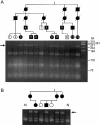Mutation analysis of the entire PKD1 gene: genetic and diagnostic implications
- PMID: 11115377
- PMCID: PMC1234934
- DOI: 10.1086/316939
Mutation analysis of the entire PKD1 gene: genetic and diagnostic implications
Abstract
Mutation screening of the major autosomal dominant polycystic kidney disease (ADPKD) locus, PKD1, has proved difficult because of the large transcript and complex reiterated gene region. We have developed methods, employing long polymerase chain reaction (PCR) and specific reverse transcription-PCR, to amplify all of the PKD1 coding area. The gene was screened for mutations in 131 unrelated patients with ADPKD, using the protein-truncation test and direct sequencing. Mutations were identified in 57 families, and, including 24 previously characterized changes from this cohort, a detection rate of 52.3% was achieved in 155 families. Mutations were found in all areas of the gene, from exons 1 to 46, with no clear hotspot identified. There was no significant difference in mutation frequency between the single-copy and duplicated areas, but mutations were more than twice as frequent in the 3' half of the gene, compared with the 5' half. The majority of changes were predicted to truncate the protein through nonsense mutations (32%), insertions or deletions (29.6%), or splicing changes (6.2%), although the figures were biased by the methods employed, and, in sequenced areas, approximately 50% of all mutations were missense or in-frame. Studies elsewhere have suggested that gene conversion may be a significant cause of mutation at PKD1, but only 3 of 69 different mutations matched PKD1-like HG sequence. A relatively high rate of new PKD1 mutation was calculated, 1.8x10-5 mutations per generation, consistent with the many different mutations identified (69 in 81 pedigrees) and suggesting significant selection against mutant alleles. The mutation detection rate, in this study, of >50% is comparable to that achieved for other large multiexon genes and shows the feasibility of genetic diagnosis in this disorder.
Figures




Similar articles
-
Identification of mutations in the duplicated region of the polycystic kidney disease 1 gene (PKD1) by a novel approach.Am J Hum Genet. 1997 Jun;60(6):1399-410. doi: 10.1086/515467. Am J Hum Genet. 1997. PMID: 9199561 Free PMC article.
-
Screening the 3' region of the polycystic kidney disease 1 (PKD1) gene reveals six novel mutations.Am J Hum Genet. 1996 Jan;58(1):86-96. Am J Hum Genet. 1996. PMID: 8554072 Free PMC article.
-
Novel and de novo PKD1 mutations identified by multiple restriction fragment-single strand conformation polymorphism (MRF-SSCP).BMC Med Genet. 2004 Feb 3;5:2. doi: 10.1186/1471-2350-5-2. BMC Med Genet. 2004. PMID: 15018634 Free PMC article.
-
Mutational analysis within the 3' region of the PKD1 gene in Japanese families.Mutat Res. 2001 Dec;458(3-4):77-84. doi: 10.1016/s0027-5107(01)00226-3. Mutat Res. 2001. PMID: 11691639
-
Polycystic kidney disease. 1: Identification and analysis of the primary defect.J Am Soc Nephrol. 1995 Oct;6(4):1125-33. doi: 10.1681/ASN.V641125. J Am Soc Nephrol. 1995. PMID: 8589278 Review.
Cited by
-
A novel splicing mutation in the PKD1 gene causes autosomal dominant polycystic kidney disease in a Chinese family: a case report.BMC Med Genet. 2018 Nov 13;19(1):198. doi: 10.1186/s12881-018-0706-6. BMC Med Genet. 2018. PMID: 30424739 Free PMC article.
-
Molecular Diagnosis and Identification of Novel Pathogenic Variants in a Large Cohort of Italian Patients Affected by Polycystic Kidney Diseases.Genes (Basel). 2023 Jun 8;14(6):1236. doi: 10.3390/genes14061236. Genes (Basel). 2023. PMID: 37372416 Free PMC article.
-
Incompletely penetrant PKD1 alleles suggest a role for gene dosage in cyst initiation in polycystic kidney disease.Kidney Int. 2009 Apr;75(8):848-55. doi: 10.1038/ki.2008.686. Epub 2009 Jan 21. Kidney Int. 2009. PMID: 19165178 Free PMC article.
-
Triplex H-DNA structure: the long and winding road from the discovery to its role in human disease.NAR Mol Med. 2024 Dec 5;1(4):ugae024. doi: 10.1093/narmme/ugae024. eCollection 2024 Oct. NAR Mol Med. 2024. PMID: 39723156 Free PMC article.
-
Cleavage of polycystin-1 requires the receptor for egg jelly domain and is disrupted by human autosomal-dominant polycystic kidney disease 1-associated mutations.Proc Natl Acad Sci U S A. 2002 Dec 24;99(26):16981-6. doi: 10.1073/pnas.252484899. Epub 2002 Dec 13. Proc Natl Acad Sci U S A. 2002. PMID: 12482949 Free PMC article.
References
Electronic-Database Information
-
- GenBank, http://www.ncbi.nlm.nih.gov/Database/index.html (for PKD1 genomic sequence [L39891], PKD1 cDNA sequence [L33243], and polycystin-1 [AAC377576])
-
- Online Human Gene Mutation Database (HGMD), http://www.uwcm.ac.uk/uwcm/mg/hgmd0.html
-
- Online Mendelian Inheritance in Man (OMIM), http://www.ncbi.nlm.nih.gov/omim
References
-
- Chen X-Z, Vassilev PM, Basora N, Peng J-B, Nomura H, Segal Y, Brown EM, Reeders ST, Hediger MA, Zhou J (1999) Polycystin-L is a calcium-regulated cation channel permeable to calcium ions. Nature 401:383–386 - PubMed
-
- Cooper DN, Krawczak M, Antonorakis SE (1995) The nature and mechanisms of human gene mutation. In: Scriver C, Beaudet AL, Sly WS, Valle D (eds) Metabolic and Molecular Bases of Inherited Disease. McGraw-Hill, New York, pp 259–291
-
- Culbertson MR (1999) RNA surveillance. Unforeseen consequences for gene expression, inherited genetic disorders and cancer. Trends Genet 15:74–80 - PubMed
-
- Dalgaard OZ (1957) Bilateral polycystic disease of the kidneys: a follow-up of two hundred and eighty-four patients and their families. Acta Med Scand Suppl 328:1–255 - PubMed
Publication types
MeSH terms
Substances
Grants and funding
LinkOut - more resources
Full Text Sources
Other Literature Sources
Medical
Molecular Biology Databases

